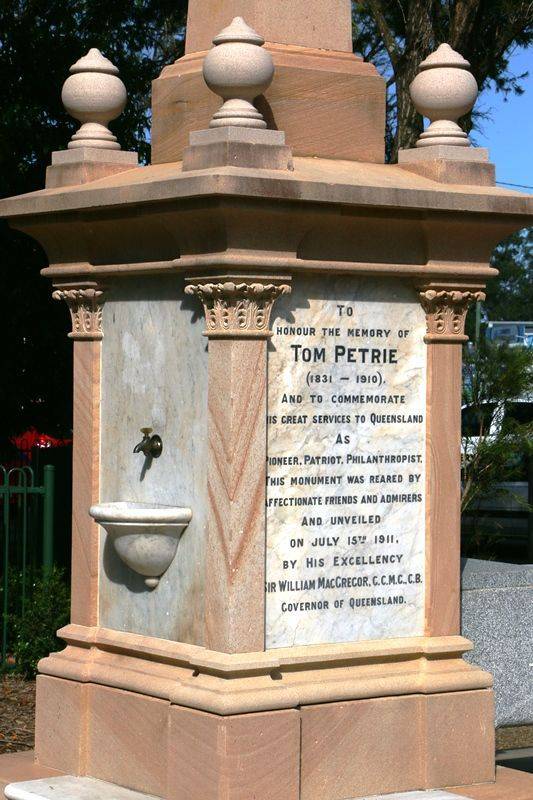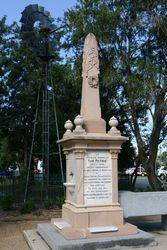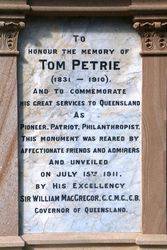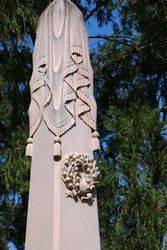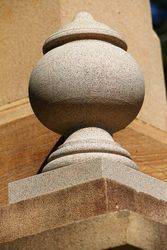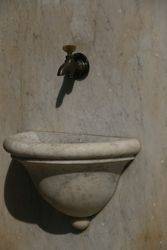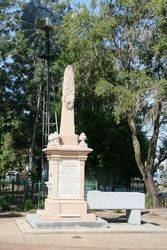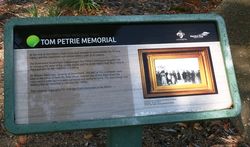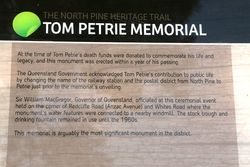
Tom PetriePrint Page 
The monument, which includes the cattle trough, was erected to commemorate Tom Petrie, explorer, grazier and friend of the Aboriginals. The monument also contained a drinking fountain.
The monument was restored in 2010 and moved to a prominent place outside the North Pine School of Arts.
Thomas Petrie arrived with his parents at Sydney in the Stirling Castle in October 1831 and moved with them to Moreton Bay in 1837. Educated by a convict clerk, he was allowed to mix freely with Aboriginal children. He learnt to speak the Brisbane tribal dialect (Turrabul) and was encouraged to share in all their activities. At 14 he was taken on the triennial walkabout to the feast at the Bunya Range. Accepted by the Aboriginals as a friend, he was in constant demand as a messenger or companion for exploration expeditions.
During journeys with his father he gathered a knowledge of surveying and bushcraft and an intimate acquaintance with the Brisbane district and its settlers. When the Douglas ministry opened Queensland`s first Aboriginal reserve on Bribie Island in 1877, Petrie became its chief adviser and overseer. The experiment was terminated next year by Palmer largely because Petrie`s report on Aboriginal attitudes and activities was not encouraging. He played little part in politics but was a foundation member of both the Caboolture and Redcliffe divisional boards and for years returning officer for Moreton electorate. Thomas Petrie died on August 26, 1910.
His Excellency, Sir William MacGregor on Saturday afternoon, at North Pine, unveiled a monument which has been erected to the memory of the late Mr. Thomas Petrie, one of Queensland's most notable pioneers. His Excellency, in the course of a long speech, recorded in the Brisbane newspapers, said there was only one Mr. Tom Petrie and could only be one. That could be said without hesitation, for Mr. Petrie had been a man with natural and peculiar talents. No other man could live the life he had lived in the district; the place he had left in the community and the State was impossible for any other man to fill. His Excellency said that, some years ago, he had the great privilege of having been brought into personal contact with Mr. Petrie for two or three days, and had then had the opportunity of learning the characteristics of the man: and the characteristics which had impressed him were his unselfishness, his complete want of pretension, and above all, his complete and entirely sympathetic nature. These were qualities which made the man respected and esteemed by all mankind, whether, black, brown or white. Fortunately, he said, Tom Petrie would not be forgotten— his name would live and his reminiscences be consulted, and be of great authority, when many people of the State would be forgotten, and, he added, generations hence, those reminiscences will be read and quoted.
Darling Downs Gazette (Qld.), 18 July 1911.
Location
| Address: | ANZAC Avenue, Petrie Place, Petrie, 4502 |
|---|---|
| State: | QLD |
| Area: | AUS |
| GPS Coordinates: | Lat: -27.269503 Long: 152.978528 Note: GPS Coordinates are approximate. |
Details
| Monument Type: | Monument |
|---|---|
| Monument Theme: | People |
| Sub-Theme: | Exploration |
| Link: | http://adbonline.anu.edu.au/adbonli… |
Dedication
| Actual Monument Dedication Date: | Saturday 15th July, 1911 |
|---|
To honour the memory of Tom Petrie (1831 - 1910).
And to commemorate his great services to Queensland as pioneer, patriot, philanthropist.
This monument was reared by affectionate friends and admirers and unveiled on July 15th 1911, by His Excellency Sir William MacGregor, G.C.M.G., C.B., Governor of Queensland.
The North Pine Heritage Trail
Tom Petrie Memorial
At the time of Tom Petrie`s death funds were donated to commemorate his life and legacy. The Queensland Government acknowledged Tom Petrie`s contribution to public life by changing the name of the railway station and the postal district from North Pine to Petrie just prior to the memorial`s unveiling.
Sir William MacGregor, Governor of Queensland, officiated at this ceremonial event held on the corner of Redcliffe Road (ANZAC Avenue) and Whites Road where the monument`s water features were connected to a nearby windmill. The stock trough and drinking fountain remained in use until the 1960s.
This memorial is arguably the most significant monument in the district.


